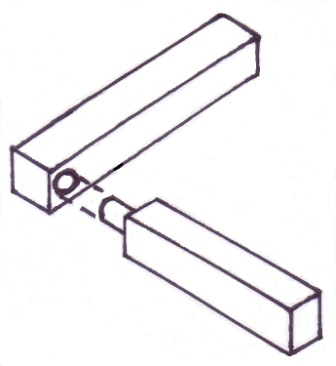You are using an out of date browser. It may not display this or other websites correctly.
You should upgrade or use an alternative browser.
You should upgrade or use an alternative browser.
Self centering dowel jig?
- Thread starter transatlantic
- Start date

Help Support UKworkshop.co.uk:
This site may earn a commission from merchant affiliate
links, including eBay, Amazon, and others.
transatlantic
Boom!
ah, I see what you mean. I wanted to dado it because I think it looks cleaner and hides the end grain of the ply wood.
...I know it's only a shop stand, but it's all practise
...I know it's only a shop stand, but it's all practise
woodbrains
Established Member
transatlantic":ysq9lcy1 said:ah, I see what you mean. I wanted to dado it because I think it looks cleaner and hides the end grain of the ply wood.
...I know it's only a shop stand, but it's all practise
Hello,
I don't think you mean dado, I think you want to put the ply in a groove, or a rebate. Incidentally dado is usually called housing in Britain, though we know what you mean.
Mike.
lurker
Le dullard de la commune
This being a UK forum I'd really like the term dado banned :evil: :evil: :evil:
Its a housing old chap !
edit: Mike beat me to it
Its a housing old chap !
edit: Mike beat me to it
transatlantic
Boom!
Righto! 
Must admit though, never heard it called housing.
Must admit though, never heard it called housing.
memzey
Established Member
I understand a housing to be cut across the grain and a groove to be cut along it. Could be well wrong though!
Steve Maskery
Established Member
memzey":neizfhyh said:I understand a housing to be cut across the grain and a groove to be cut along it. Could be well wrong though!
That is quite correct.
Like the OP, I am also looking for a self-centering dowel jig. Despite its limited application and the shortage of "extras" - in comparison to the Woodpecker jig, I think the self-centering jig available from Banggood is worth a punt (I can't post a link sorry) Just google: "banggood dowelling jig". - it's only £47.
I've had a lot of electronic components from these folks and I've always found them to be good value.
The construction seems robust enough and the materials used are (apparently) solid enough. I am particularly interested because it's got the three sets of bushings.
As I said, I'm aware of the drawbacks - but it does seem reasonable eh?
There's the Woodpecker version in action to be seen on Youtube.
I've had a lot of electronic components from these folks and I've always found them to be good value.
The construction seems robust enough and the materials used are (apparently) solid enough. I am particularly interested because it's got the three sets of bushings.
As I said, I'm aware of the drawbacks - but it does seem reasonable eh?
There's the Woodpecker version in action to be seen on Youtube.
transatlantic
Boom!
Thats pretty much the same thing I posted from ebay :
http://www.ebay.co.uk/itm/Self-Centerin ... 2699741867
Although it looks good, it still doesnt really help with the following kind of scenario :

Where you're building a frame from small, say 2x2 pieces, which I find I'm wanting to do most of (like attaching rails to legs for a table). It'll be good with the left most piece, but awkward with the right most piece as there is very little area for the jig to reference. I guess you could bunch more than one piece togeather to give you more surface, but it's not ideal.
It looks like it's only good for these kinds of joints where you have more width :

http://www.ebay.co.uk/itm/Self-Centerin ... 2699741867
Although it looks good, it still doesnt really help with the following kind of scenario :

Where you're building a frame from small, say 2x2 pieces, which I find I'm wanting to do most of (like attaching rails to legs for a table). It'll be good with the left most piece, but awkward with the right most piece as there is very little area for the jig to reference. I guess you could bunch more than one piece togeather to give you more surface, but it's not ideal.
It looks like it's only good for these kinds of joints where you have more width :

Transatlantic, if the discussion is still about a utilitarian workshop stand, there's a simple option for your first picture - clamp the parts together and drill holes through both pieces, from the outside. Glue some dowels and knock them in. Flush off the ends when the glue is dry.
This way you can even deliberately angle the dowels, like skew nailing, which you can't do with any commercial jig.
This way you can even deliberately angle the dowels, like skew nailing, which you can't do with any commercial jig.
transatlantic
Boom!
AndyT":1tvkmh7u said:Transatlantic, if the discussion is still about a utilitarian workshop stand, there's a simple option for your first picture - clamp the parts together and drill holes through both pieces, from the outside. Glue some dowels and knock them in. Flush off the ends when the glue is dry.
This way you can even deliberately angle the dowels, like skew nailing, which you can't do with any commercial jig.
Thanks Andy. I had thought of that, but was also looking for ways to make it hidden
Similar threads
- Replies
- 0
- Views
- 625
- Replies
- 1
- Views
- 886





